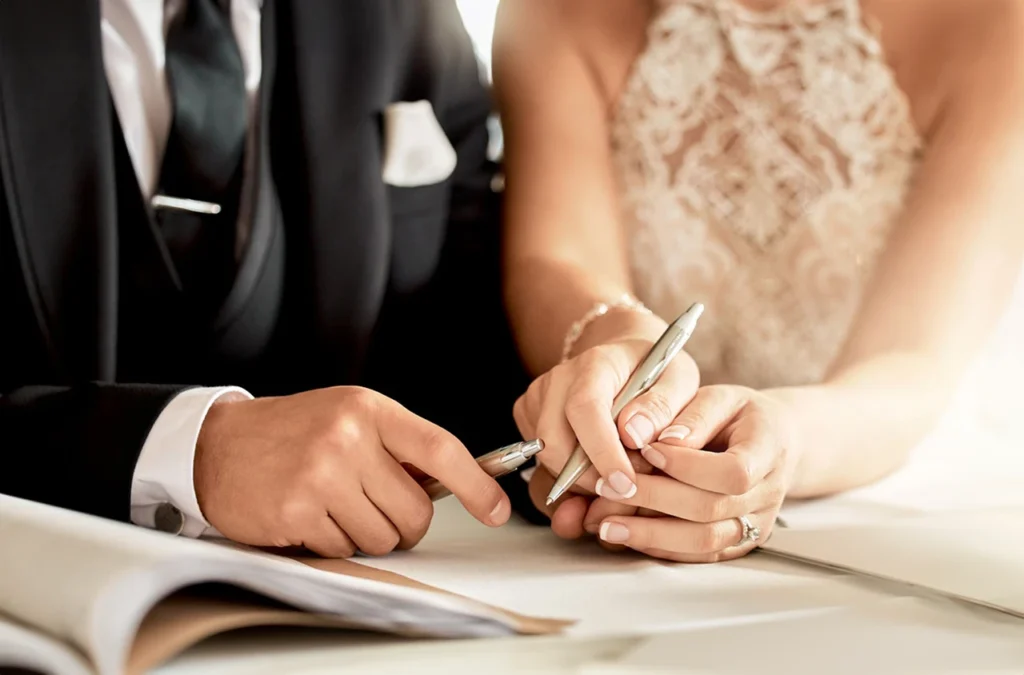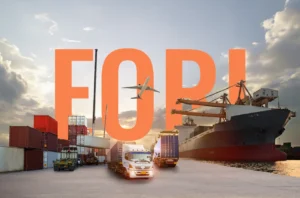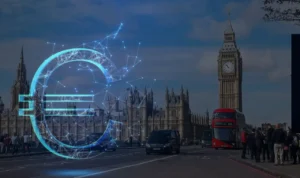Contents
Marriage allowance offers married or civil partners tax savings of up to £252 for the 2024/25 tax year. This article provides a comprehensive introduction to this ‘transferable tax allowance,’ how to claim marriage allowance according to the couple’s circumstances, and other forms of tax breaks married partners may take advantage of.
What Is Marriage Allowance [2024]
Marriage allowance, also called ‘marriage tax allowance,’ is a form of tax break for civil or married partners that allows the low-earning spouse (donor) to transfer a ‘portion’ of unused personal allowance to the higher-earning partner (recipient).
This allowance is not to be confused with the married couple’s allowance/MCA (see below for more information about other forms of tax breaks for couples).

Who Is Eligible for Marriage Allowance
Couples qualify for the marriage allowance under these conditions:
- They are a married couple or civil partner.
- They are born after 5 April 1935 (born before this date, married couple allowance applies).
- They are not using the married couple allowance.
- One of the partners earn less than the personal allowance (less than £12,570 for the 2024/25 tax year) or do not pay income tax. The other must be a basic rate taxpayer (with taxable income between £12,571 and £50,270), whether employed or self-employed.
- The income condition above does not apply to Scotland where the starter rate (basic or intermediate) applies. One of the Scottish couples must earn between £12,571 and £43,662.
- Couples may still qualify even if one is not employed, given that the other spouse is a basic rate taxpayer.
- They can also apply even if they are receiving state pension or living abroad (given they have a personal allowance).
How Marriage Allowance Works
Civil or married partners claiming marriage allowance may save up to £252 altogether for the current tax year. The low-earning partner transfers £1,260 (just over 10% portion of their total personal allowance, £12,570) to their higher-earning spouse (basic income between £12,571 and £50,270).
The ‘transferred tax allowance’ serves as a tax credit to the recipient spouse, completely tax-free, resulting in tax liability deductions. However, the donating spouse will pay tax on the excess amount after £11,310. If the income stays below this amount after making the allowance transfer, there will be no tax due.
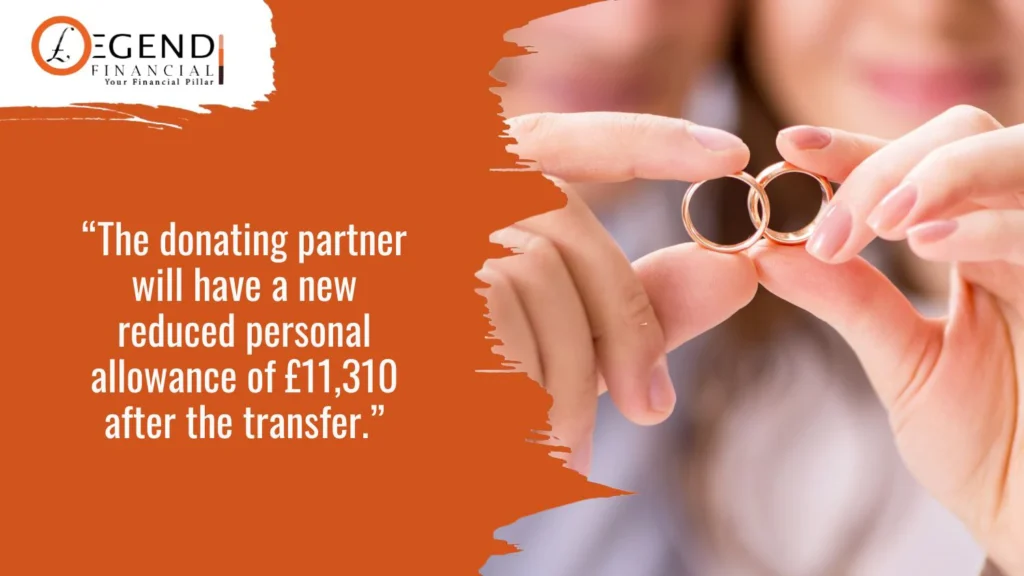
The recipient partner’s tax code will change to ‘M.’ The donating partner’s tax code, if employed, will be changed to ‘N.’ This means they are receiving and transferring marriage allowance, respectively.
How to Calculate Marriage Allowance
Here is a simple example of how marriage allowance is calculated:
Olivia and John are a married couple. Olivia works part-time, so she earns £11,500. For the 2024/25 tax year, her income falls within the personal allowance of £12,570, which means she is not liable to tax.
She claims the marriage allowance and transfers £1,260 to John, who earns £20,000. Reduced by the personal allowance, he is left with a taxable amount of £7,430. Further using the £1,260 allowance he received, his taxable income becomes £6,170.
Since Olivia transferred a portion of her allowance to her spouse, she is left with £11,310 personal allowance. As she earns £11,500, she will pay tax on the remaining £190.
The couple’s total taxable income becomes £6,360, instead of £7,430. This saves them £214 in tax overall.
How Is Marriage Allowance Received
Marriage allowance is received as a tax relief, not pay, which means the spouse will have reduced taxable income every payroll.
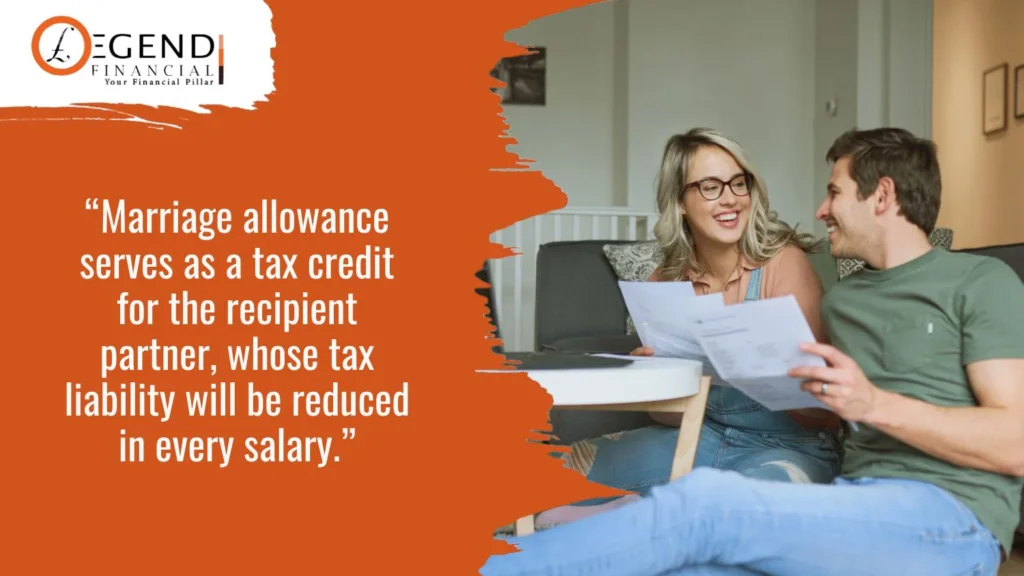
When the claim is for the current the tax year, the basic rate taxpaying partner will continue to receive the allowance every year afterwards unless the transfer is cancelled (either due to death or divorce). Take note, though, that backdated allowances are received differently, usually refunded via a cheque.
If the claim is made after the relevant tax year has ended, it will only apply to the tax year for which the claim is made.
How to Claim Marriage Allowance HMRC Online
The quickest way on how to claim marriage allowance UK is online in which applicants usually get a response within 24 hours. Each of the couples must have a National Insurance number to be able to apply online. Those who are not eligible for online application may use self assessment or the Marriage Allowance Form (MATCF).
How to Claim Marriage Allowance Through Self Assessment
The transferring partner will have to fill out the marriage allowance section in their self-assessment return. The recipient spouse will leave that space blank. Both will not need to fill out the section when their tax code ends in ‘N’ or ‘M,’ as the allowance will continue every year, depending on the timing of the claim.
If both couples file self-assessments, the donating partner must send their return at least 3 days before the recipient spouse files theirs. The couples should ensure HMRC obtains the record of the donating spouse having made the application before they have sent the return.
How to Claim Marriage Allowance for Past Years
Couples can backdate their marriage allowance claim for up to 4 years, ensuring that they qualify for each year they are making the claim. This means they can backdate from 5 April 2020 up to the present tax year.
The recipient partner will have a varying tax deduction as thresholds and tax rates for income tax frequently change.
Other Tax Reliefs for Married or Civil Partners
Married couples are eligible for other tax breaks, such as the following:
Married Couple’s Allowance
This allowance applies to couples born before 5 April 1935, with a minimum allowance currently set at £4,280 and maximum £11,080. For the 2024/25 tax year, this means tax savings between £428 and £1,037.50 in a year.
Inheritance Tax
The surviving partner may not need to pay inheritance tax on the deceased spouse’s estate due to the ‘spousal exemption,’ which allows couples to combine their lifetime transfer allowances, amounting to £1m.
Tax on Savings and Investments
Since married couples with a higher rate taxpaying partner are not eligible for marriage allowance, they have alternative means to save tax bill on their savings and investments. The higher-rate partner makes an ‘authentic’ gift transfer to the lower-rate spouse.
Capital Gains Tax
CGT exempts spousal transfers from tax, which means married partners can transfer to one another tax-free. The exemption also applies to joint name transfers, given the gift is ‘authentic.’
Bereavement Support
A surviving partner may qualify for bereavement support if their spouse died on or after 6 April 2017. The support may be in the form of a lump sum or monthly payments.
Frequently Asked Questions
Being a pensioner does not affect one’s eligibility for the marriage allowance.
Yes, if the criteria are met. If the higher earning partner died, the surviving partner should contact HMRC’s income tax helpline. If it is the lower-earning partner who died, their tax representative should be the one to reach HMRC.
Marriage allowance is also available to nonresidents if they are entitled to the personal allowance.
Nonresidents are entitled to UK personal allowance if they are citizens of any European Economic Area (EEA) country, with a British passport, and are working for the UK government in that tax year.
Benefits include marriage tax breaks, joint ownership of assets, financial settlements, prenuptial or postnuptial agreements, inheritance tax ‘spousal’ exemption, and more.
How Legend Financial Can Help
Marriage allowance is a very substantial form of tax break, but it does not mean all couples should claim it every year. This is especially true for variable-earning couples. In a tax year, for instance, a donating partner may earn more than the £11,310 allowance and the recipient spouse less than the allowance-credited £13,830. In this case, claiming marriage allowance may only leave them worse off in tax payments.
Legend Financial is your ultimate support on how to claim marriage allowance. We will advise you on every facet, including when to claim, how to backdate in the most tax-efficient way, how to file your self-assessment returns, and which other couples’ tax breaks may apply to your circumstance. Reach out to our experts today!



